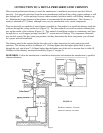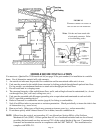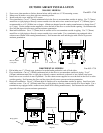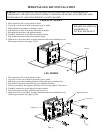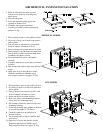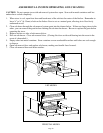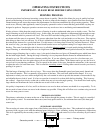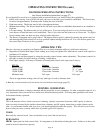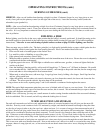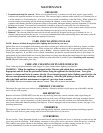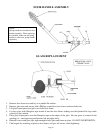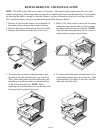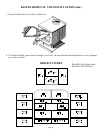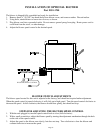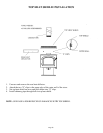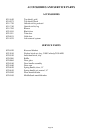OPERATING INSTRUCTIONS (cont.)
BURNING GUIDELINES (cont.)
MEDIUM: After a wood load has been burning on high for at least 15 minutes (longer for very large pieces or wet
wood), close (pull out) the primary control (on the right side of the stove). Leave the secondary control (under the
ashcatcher) open (pushed in).
LOW: After a wood load has been burning on high for at least 15 minutes (longer for very large pieces or wet wood),
close (pull out) the primary control. Then close down the secondary control, gradually making sure to maintain flames in
the stove. It is very important to maintain flames in your stove during the first few hours of a low burn, to avoid exces-
sive air pollution.
BUILDING A FIRE
Before lighting your first fire in the stove, make certain that the baffle is correctly positioned. It should be resting on the
rear baffle support so that the hole in the baffle lines up with the baffle locating pin (see page 25 for baffle installation
instructions). Also refer to care and cleaning of plated surfaces section on page 23 before lighting your first fire.
There are many ways to build a fire. The basic principle is to light easily-ignitable tinder or paper, which ignites the fast
burning kindling, which in turn ignites the slow-burning firewood. Here is one method that works well:
1. Place several wads of crushed paper on the firebox floor.
2. Lay small dry sticks of kindling on top of the paper.
3. Open primary and secondary controls fully.
4. Make sure that no matches or other combustibles are in the immediate area of the stove. Be sure the room is adequately
ventilated and the flue unobstructed.
5. Light the paper in the stove. NEVER light or rekindle stove with kerosene, gasoline, or charcoal lighter fluid; the
results can be fatal.
6. Once the kindling is burning quickly, add several full-length logs 3” (76mm) or 4” (102mm) in diameter. Be careful
not to smother the fire. Stack the pieces of wood carefully: near enough to keep each other hot, but far enough away
from each other to allow adequate air flow between them.
7. When ready to reload the stove, add more logs. Large logs burn slowly, holding a fire longer. Small logs burn fast
and hot, giving quick heat.
8. Adjust the primary and secondary air controls; the more you close down the controls, the lower and slower the fire
will burn. The more open the controls, the more heat will be produced.
As long as there are hot coals, repeating steps 7 and 8 will maintain a continuous fire throughout the season.
NOTE: The special high temperature paint that your stove is finished with will cure as your stove heats. You will notice
an odor and perhaps see some vapor rise from the stove surface; this is normal. We recommend that you open a window
until the odor dissipates and paint is cured.
NOTE: On a cold start-up, you may see a small amount of smoke coming from the underside of the stove until chimney
draft is established. This is normal, and will stop when the loading door is closed.
WOOD SELECTION AND STORAGE
Dry and well-seasoned wood will not only minimize the chance of creosote formation, but will give you the most effi-
cient fire. Even dry wood contains at least 15% moisture by weight, and should be burned hot enough to keep the chim-
ney hot for as long as it takes to dry the wood out - about one hour. It is a waste of energy to burn unseasoned wood of
any kind. Dead wood lying on the forest floor should be considered wet, and requires full seasoning time. Standing dead
wood can be considered to be about two-thirds seasoned. To tell if wood is dry enough to burn, check the ends of the
logs. If there are cracks radiating in all directions from the center, it is dry. If your wood sizzles in the fire, even though
the surface is dry, it may not be fully cured. Splitting wood before it is stored reduces drying time. Wood should be
stacked so that both ends of each piece are exposed to air, since more drying occurs through the cut ends than the sides.
This is true even with wood that has been split. Store wood under cover, such as in a shed, or covered with a tarp, plastic,
tar paper, sheets of scrap plywood, etc., as uncovered wood can absorb water from rain or snow, delaying the seasoning
process.
Page 22



